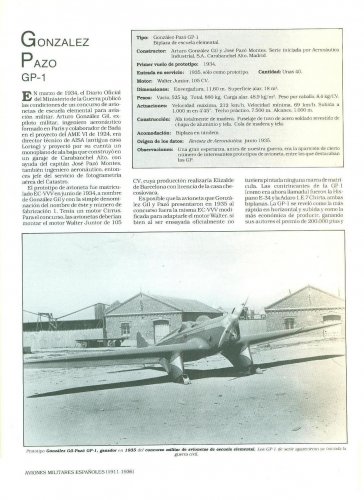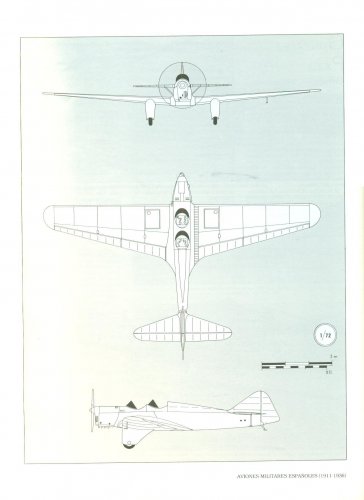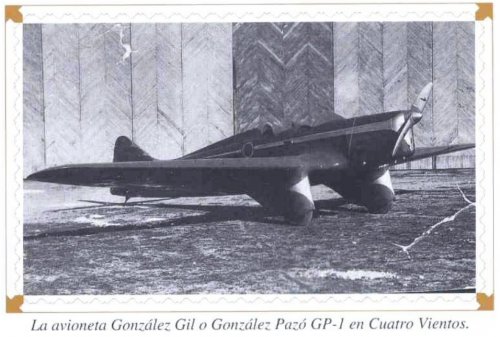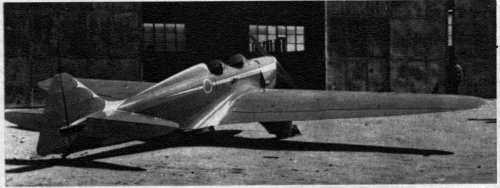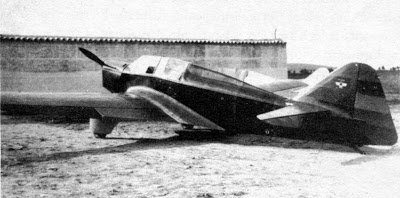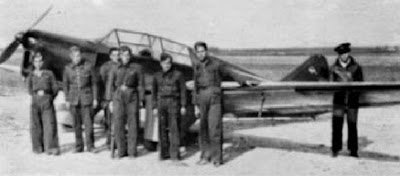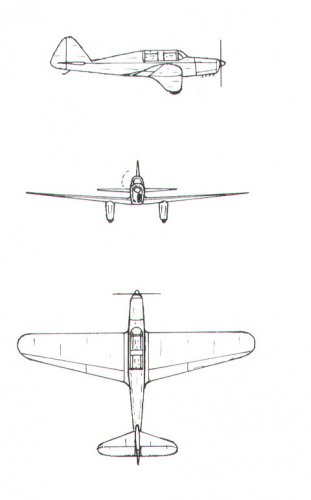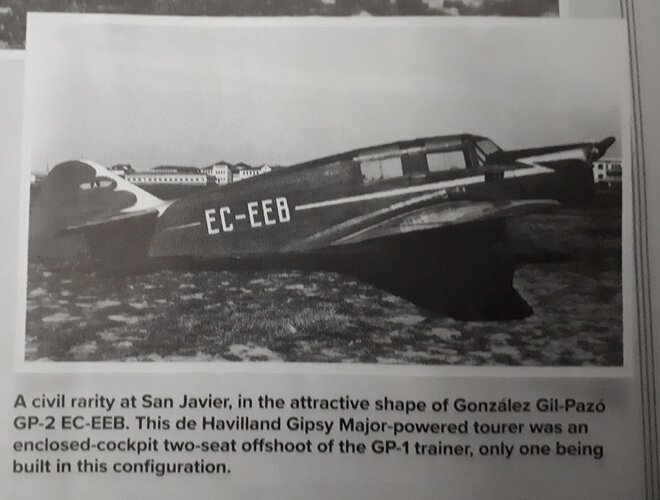You are using an out of date browser. It may not display this or other websites correctly.
You should upgrade or use an alternative browser.
You should upgrade or use an alternative browser.
Gil-Pazó/Pazó aircraft
- Thread starter Maveric
- Start date
Maveric said:I look for drawings and pics of the Gil-Pazo No.1 (not the G.P.1), first flew in June 1932.
I know the G.P.1, G.P.2 and G.P.4. Can you tell me more about the G.P.3, maybe a project?
Hi Maveric,
I know it's been a long time since you asked this question, but can you tell us the source for the early González Gil-Pazó flying in 1932 ?
I've not found anything about this, and thought that the G.P.1 was their first design.
About the G.P.3, I know nothing for sure, but I notice that the single-seat G.P. Especial came between the G.P.2 and G.P.4, this might explain why the slot was unused.
Cheers,
Adrien
I found mention of this aircraft (so-called "Gil-Pazó No.1") in the book by Howson Aircraft of the Spanish Civil War.
He says that this Gil-Pazó No.1 was similar to the Miles M.2 Hawk and had an ADC Cirrus engine. It was reportedly registered EC-VVC and first flew in June 1932. Several websites seem to copy this information from Howson's book.
What worries me is that I found no confirmation of its existence in Spanish sources, notably it is not mentioned in the book by Velarde Aviones españoles del siglo XX.
Moreover the registration EC-VVC is not logical in the Spanish registration sequence:
http://www.airhistory.org.uk/gy/reg_EC-1.html
And it is very close to EC-VVV of the first GP-1, which might indicate a confusion.
Adrien
He says that this Gil-Pazó No.1 was similar to the Miles M.2 Hawk and had an ADC Cirrus engine. It was reportedly registered EC-VVC and first flew in June 1932. Several websites seem to copy this information from Howson's book.
What worries me is that I found no confirmation of its existence in Spanish sources, notably it is not mentioned in the book by Velarde Aviones españoles del siglo XX.
Moreover the registration EC-VVC is not logical in the Spanish registration sequence:
http://www.airhistory.org.uk/gy/reg_EC-1.html
And it is very close to EC-VVV of the first GP-1, which might indicate a confusion.
Adrien
There was an article about the González Gil-Pazó aircraft in Aviation Magazine no.565, written by Dario Vecino and Jean Noel.
It is very interesting because it describes several projects that were not mentioned in any other source I know.
Here is a short summary of the aircraft designed by González Gil-Pazó and by Pazó alone, compiled from various sources:
First came the GP-1 designed and built by Arturo González Gil and José Pazó Montes. The first prototype (EC-VVV) was blue-gray with silver cheatlines (see pictures posted below). It first flew in June 1934 . (Note: it is quite clear that the so-called "Gil-Pazo No.1" discussed in above posts and supposedly flown in 1932 actually does not exist.)
The prototype originally had a Cirrus engine that was replaced by a Walter Junior 105 hp, which was a mandatory equipment for the training aircraft competition organized by the Spanish military in 1935. It won the competition against three other competitors: the Hispano E-34, Adaro 1.E.7 Chirta and Loring X.
This prompted an order for 100 aircraft, whose production was undertaken by AISA (ex-Loring). Because of the civil war, the number of aircraft actually built is not known exactly, but is supposed to be about 40. About 30 aircraft survived the conflict and were used by the military and by aeroclubs.
It is very interesting because it describes several projects that were not mentioned in any other source I know.
Here is a short summary of the aircraft designed by González Gil-Pazó and by Pazó alone, compiled from various sources:
First came the GP-1 designed and built by Arturo González Gil and José Pazó Montes. The first prototype (EC-VVV) was blue-gray with silver cheatlines (see pictures posted below). It first flew in June 1934 . (Note: it is quite clear that the so-called "Gil-Pazo No.1" discussed in above posts and supposedly flown in 1932 actually does not exist.)
The prototype originally had a Cirrus engine that was replaced by a Walter Junior 105 hp, which was a mandatory equipment for the training aircraft competition organized by the Spanish military in 1935. It won the competition against three other competitors: the Hispano E-34, Adaro 1.E.7 Chirta and Loring X.
This prompted an order for 100 aircraft, whose production was undertaken by AISA (ex-Loring). Because of the civil war, the number of aircraft actually built is not known exactly, but is supposed to be about 40. About 30 aircraft survived the conflict and were used by the military and by aeroclubs.
Attachments
With the prize money obtained at the training aircraft competition, Arturo González Gil and José Pazó Montes created the company CAP (Construcción de Aviones Prototipo), to develop new versions.
The first project by CAP (mentioned in Aviation Magazine) was a single-engine monoplane bomber, intended to replace the CASA Breguet 19 in service with the Spanish military.
The next model was the GP-2 two-seat cabin aircraft, with a DH Gipsy Major 130 hp engine and larger fuel tanks. The only example whose existence is confirmed was registered EC-EEB and owned by Ramón Torres, who made long distance flights with it in early 1936. Some sources mention a second aircraft, but its existence is unsure.
The only picture I've found of the original two-seat GP-2 is that reproduced below, from the book by Velarde:
http://www.fio.es/velarde/
(Many pictures supposedly showing a GP-2 actually show something else, like a GP Especial, a GP-4, or a GP-1 modified with a makeshift cabin.)
There was a single-seat variant, the GP Especial, of which two were made:
- EC-BEE, owned by Lorenzo Richi, who flew from Spain to Equatorial Guinea in January 1936 (two pictures below)
- EC-FFB "Numancia", owned by José Vélaz de Medrano, who planned to cross the Atlantic with it (no picture found in original condition)
(Recent books distinguish the two-seat GP-2 and single-seat GP Especial as two separate models. The name GP-2 Especial is also found, and the single-seat aircraft are counted among the GP-2 in the article by Dario Vecino. At the time, those aircraft were sometimes called GP-1 in the press, by analogy with the standard military trainer.)
During the war, EC-FFB was registered EG-042 with the Republican air force, and was modified with a second open cockpit at the front. After the war, it was re-registered EC-AAM and a makeshift cabin was made to cover this additional cockpit.
Details of this aircraft are found in this website: http://mchuliaq.blogspot.fr/2014/09/el-golpe.html
and good pictures of the aircraft as EG-042 and EC-AAM are found here (smaller reproductions posted below):
http://www.aviationcorner.net/gallery_en.asp?registration=EG-042
http://www.aviationcorner.net/gallery_en.asp?registration=EC-AAM
The first project by CAP (mentioned in Aviation Magazine) was a single-engine monoplane bomber, intended to replace the CASA Breguet 19 in service with the Spanish military.
The next model was the GP-2 two-seat cabin aircraft, with a DH Gipsy Major 130 hp engine and larger fuel tanks. The only example whose existence is confirmed was registered EC-EEB and owned by Ramón Torres, who made long distance flights with it in early 1936. Some sources mention a second aircraft, but its existence is unsure.
The only picture I've found of the original two-seat GP-2 is that reproduced below, from the book by Velarde:
http://www.fio.es/velarde/
(Many pictures supposedly showing a GP-2 actually show something else, like a GP Especial, a GP-4, or a GP-1 modified with a makeshift cabin.)
There was a single-seat variant, the GP Especial, of which two were made:
- EC-BEE, owned by Lorenzo Richi, who flew from Spain to Equatorial Guinea in January 1936 (two pictures below)
- EC-FFB "Numancia", owned by José Vélaz de Medrano, who planned to cross the Atlantic with it (no picture found in original condition)
(Recent books distinguish the two-seat GP-2 and single-seat GP Especial as two separate models. The name GP-2 Especial is also found, and the single-seat aircraft are counted among the GP-2 in the article by Dario Vecino. At the time, those aircraft were sometimes called GP-1 in the press, by analogy with the standard military trainer.)
During the war, EC-FFB was registered EG-042 with the Republican air force, and was modified with a second open cockpit at the front. After the war, it was re-registered EC-AAM and a makeshift cabin was made to cover this additional cockpit.
Details of this aircraft are found in this website: http://mchuliaq.blogspot.fr/2014/09/el-golpe.html
and good pictures of the aircraft as EG-042 and EC-AAM are found here (smaller reproductions posted below):
http://www.aviationcorner.net/gallery_en.asp?registration=EG-042
http://www.aviationcorner.net/gallery_en.asp?registration=EC-AAM
Attachments
-
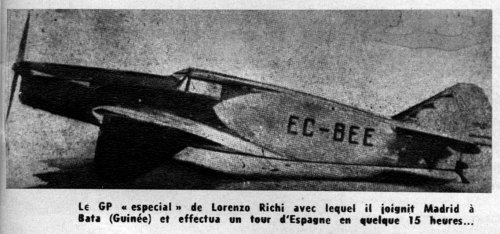 gonzalez_pazo_GP_Especial_EC-BEE_avimag_565_p81.jpg193.2 KB · Views: 109
gonzalez_pazo_GP_Especial_EC-BEE_avimag_565_p81.jpg193.2 KB · Views: 109 -
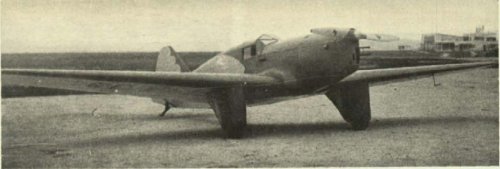 gonzalez_pazo_GP_Especial_EC-BEE_aviacion_y_deportes_1936-02_p33s.jpg71.6 KB · Views: 93
gonzalez_pazo_GP_Especial_EC-BEE_aviacion_y_deportes_1936-02_p33s.jpg71.6 KB · Views: 93 -
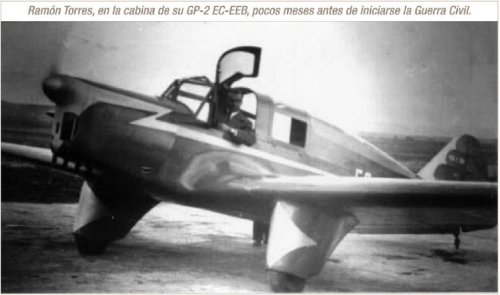 gonzalez_pazo_GP-2_EC-EEB_velarde_p165s.jpg60.5 KB · Views: 95
gonzalez_pazo_GP-2_EC-EEB_velarde_p165s.jpg60.5 KB · Views: 95 -
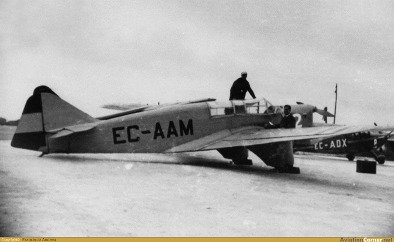 gonzalez_pazo_GP_Especial_EC-AAM_aviationcorner-francisco-andreu-s.jpg24.2 KB · Views: 98
gonzalez_pazo_GP_Especial_EC-AAM_aviationcorner-francisco-andreu-s.jpg24.2 KB · Views: 98 -
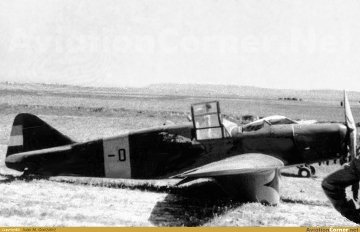 gonzalez_pazo_GP_Especial_EG-042_aviationcorner-juan-gonzalez-s.jpg46 KB · Views: 102
gonzalez_pazo_GP_Especial_EG-042_aviationcorner-juan-gonzalez-s.jpg46 KB · Views: 102
These pictures are identified as a GP-2 in
http://mchuliaq.blogspot.fr/2014/09/el-golpe.html
but I think they show a GP-1 modified with a makeshift cabin.
http://mchuliaq.blogspot.fr/2014/09/el-golpe.html
but I think they show a GP-1 modified with a makeshift cabin.
Attachments
No record has been found of a GP-3.
The next model was the GP-4, a four-seat cabin version. Engineer Ricardo Valle participated in the design, with new fuel tanks and improved shock absorbers.
Only one aircraft was made, registered EC-AFM, in silver gray with red registrations and cheatlines. It was impressed by the Republican and a red band was painted at least on the fuselage. José Pazó used it to join the Nationalists in September 1936. (Arturo González Gil had opposite political views and died fighting as a foot soldier with the Republicans.)
The GP-4 was then used by the Nationalist air force with the code 30-20, painted in dark blue according to Dario Vecino. After the war, it became civil again as EC-AAZ, officially registered as a "GP-2".
Some pictures of the aircraft can be found here:
http://www.aviationcorner.net/gallery_en.asp?registration=EC-AAZ
http://www.aviationcorner.net/gallery_en.asp?registration=EC-AFM
The next model was the GP-4, a four-seat cabin version. Engineer Ricardo Valle participated in the design, with new fuel tanks and improved shock absorbers.
Only one aircraft was made, registered EC-AFM, in silver gray with red registrations and cheatlines. It was impressed by the Republican and a red band was painted at least on the fuselage. José Pazó used it to join the Nationalists in September 1936. (Arturo González Gil had opposite political views and died fighting as a foot soldier with the Republicans.)
The GP-4 was then used by the Nationalist air force with the code 30-20, painted in dark blue according to Dario Vecino. After the war, it became civil again as EC-AAZ, officially registered as a "GP-2".
Some pictures of the aircraft can be found here:
http://www.aviationcorner.net/gallery_en.asp?registration=EC-AAZ
http://www.aviationcorner.net/gallery_en.asp?registration=EC-AFM
Attachments
-
 gonzalez_pazo_GP-4_30-_profil_avimag_565_p85s.jpg45 KB · Views: 116
gonzalez_pazo_GP-4_30-_profil_avimag_565_p85s.jpg45 KB · Views: 116 -
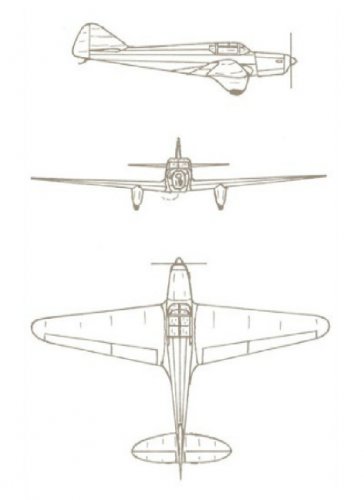 gonzalez_pazo_GP-4_plan_velarde_p175s.jpg26.1 KB · Views: 108
gonzalez_pazo_GP-4_plan_velarde_p175s.jpg26.1 KB · Views: 108 -
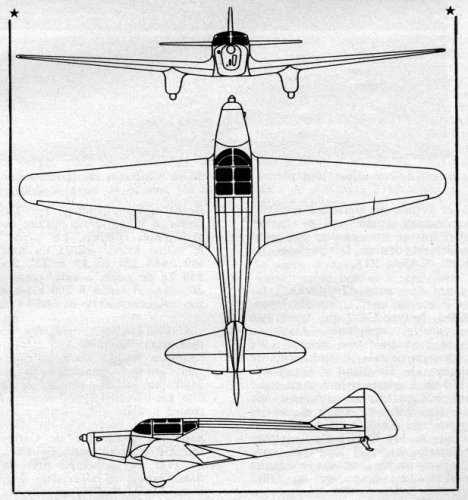 gonzalez_pazo_GP-4_plan_avimag_565_p81s.jpg115.9 KB · Views: 113
gonzalez_pazo_GP-4_plan_avimag_565_p81s.jpg115.9 KB · Views: 113 -
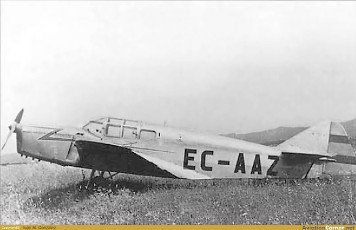 gonzalez_pazo_GP-4_EC-AAZ_aviationcorner-juan-gonzalez-s.jpg20 KB · Views: 98
gonzalez_pazo_GP-4_EC-AAZ_aviationcorner-juan-gonzalez-s.jpg20 KB · Views: 98 -
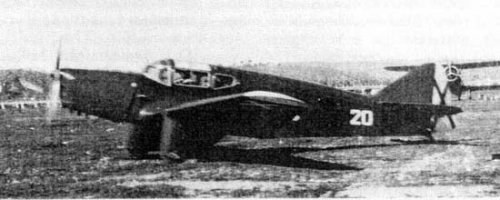 gonzalez_pazo_GP-4_30-20_airwar.ru.jpg46.2 KB · Views: 87
gonzalez_pazo_GP-4_30-20_airwar.ru.jpg46.2 KB · Views: 87 -
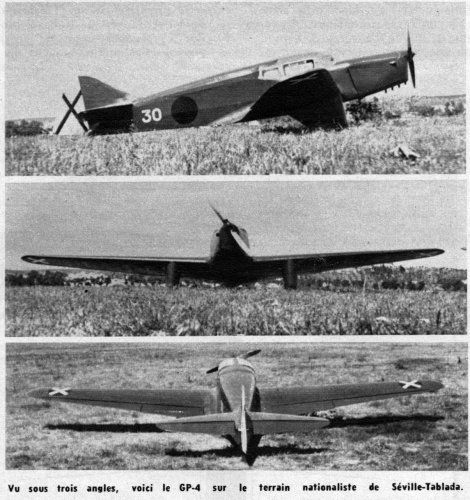 gonzalez_pazo_GP-4_30-_avimag_565_p82.jpg508 KB · Views: 88
gonzalez_pazo_GP-4_30-_avimag_565_p82.jpg508 KB · Views: 88 -
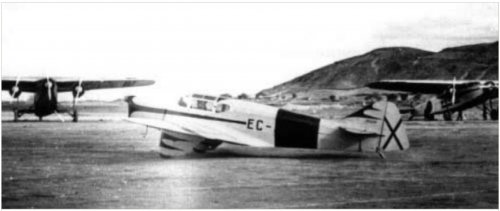 gonzalez_pazo_GP-4_EC-AFM_velarde_p175.jpg233.7 KB · Views: 98
gonzalez_pazo_GP-4_EC-AFM_velarde_p175.jpg233.7 KB · Views: 98 -
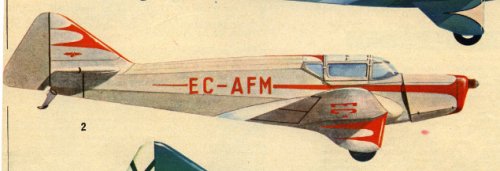 gonzalez_pazo_GP-4_EC-AFM_profil_avimag_565_p85s.jpg50.5 KB · Views: 100
gonzalez_pazo_GP-4_EC-AFM_profil_avimag_565_p85s.jpg50.5 KB · Views: 100 -
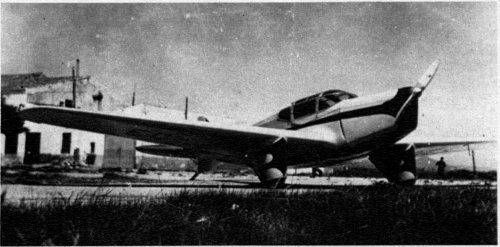 gonzalez_pazo_GP-4_EC-AFM_avimag_565_p81.jpg206.2 KB · Views: 96
gonzalez_pazo_GP-4_EC-AFM_avimag_565_p81.jpg206.2 KB · Views: 96
After he joined the Nationalist side, José Pazó became chief engineer at the Maestranza (maintenance center) in Tablada, Sevilla. He studied several aircraft projects:
- the P-III "liaison" four-seat cabin aircraft with Argus As-10C 240 hp engine and fixed spatted gear
- the P-III "fast transport", a single-seat record aircraft with Hirth engine (apparently an HM-8V 225 hp) and retractable gear (similar to that of the He 70), studied for Nationalist ace García Morato for possible record attempts after the war
- the P-IV two-seat tandem cabin aircraft
- the P-IV A, similar to the P-IV with two open cockpits
- two further single-seat record aircraft for García Morato, evolved from the P-III "fast transport": the P-5 A (with Argus As-10 C) and P-5 B (with Hirth 506 A), with a provisional fixed gear that would have been replaced by a retractable gear after the flight tests.
The designs were influenced by German aircraft like the Klemm or Taifun, and used German construction standards (instead of French or British standards on the earlier GP).
The only aircraft that was actually built was the P-IV two-seat cabin model. It first flew unpainted in 1939, and later received the military registration 30-177 and was painted light gray, like the Buckers.
José Pazó was nominated as air attaché in Rome, then in Berlin. When he came back, he was absorbed in other tasks and stopped aircraft design altogether.
The GP aircraft had other distant successors in the HM aircraft designed in the 1940s by Huarte Mendicoa at INTA and built by AISA, which were originally based on the GP-1.
- the P-III "liaison" four-seat cabin aircraft with Argus As-10C 240 hp engine and fixed spatted gear
- the P-III "fast transport", a single-seat record aircraft with Hirth engine (apparently an HM-8V 225 hp) and retractable gear (similar to that of the He 70), studied for Nationalist ace García Morato for possible record attempts after the war
- the P-IV two-seat tandem cabin aircraft
- the P-IV A, similar to the P-IV with two open cockpits
- two further single-seat record aircraft for García Morato, evolved from the P-III "fast transport": the P-5 A (with Argus As-10 C) and P-5 B (with Hirth 506 A), with a provisional fixed gear that would have been replaced by a retractable gear after the flight tests.
The designs were influenced by German aircraft like the Klemm or Taifun, and used German construction standards (instead of French or British standards on the earlier GP).
The only aircraft that was actually built was the P-IV two-seat cabin model. It first flew unpainted in 1939, and later received the military registration 30-177 and was painted light gray, like the Buckers.
José Pazó was nominated as air attaché in Rome, then in Berlin. When he came back, he was absorbed in other tasks and stopped aircraft design altogether.
The GP aircraft had other distant successors in the HM aircraft designed in the 1940s by Huarte Mendicoa at INTA and built by AISA, which were originally based on the GP-1.
Attachments
-
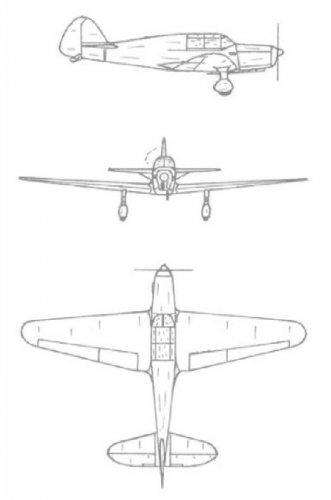 pazo_P-IV_plan_velarde_p288s.jpg21 KB · Views: 110
pazo_P-IV_plan_velarde_p288s.jpg21 KB · Views: 110 -
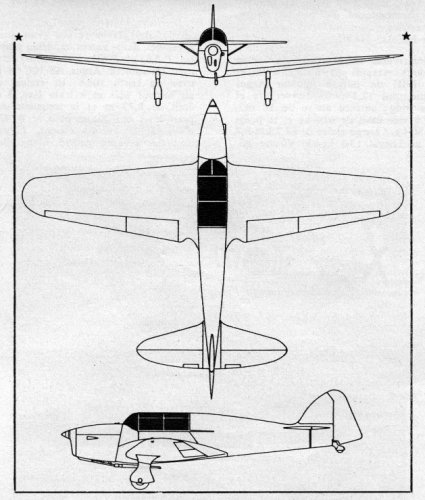 pazo_P-IV_plan_avimag_565_p83s.jpg126.1 KB · Views: 107
pazo_P-IV_plan_avimag_565_p83s.jpg126.1 KB · Views: 107 -
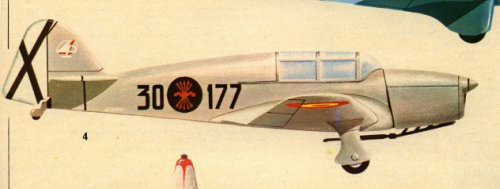 pazo_P-IV_30-177_profil_avimag_565_p85s.jpg50.2 KB · Views: 110
pazo_P-IV_30-177_profil_avimag_565_p85s.jpg50.2 KB · Views: 110 -
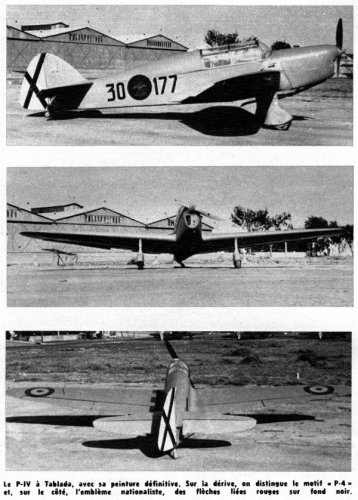 pazo_P-IV_30-177_avimag_565_p84s.jpg171.9 KB · Views: 103
pazo_P-IV_30-177_avimag_565_p84s.jpg171.9 KB · Views: 103 -
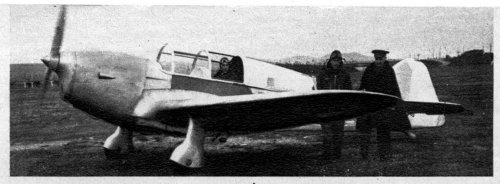 pazo_P-IV_non_peint_premier_vol_avimag_565_p83.jpg153.4 KB · Views: 97
pazo_P-IV_non_peint_premier_vol_avimag_565_p83.jpg153.4 KB · Views: 97 -
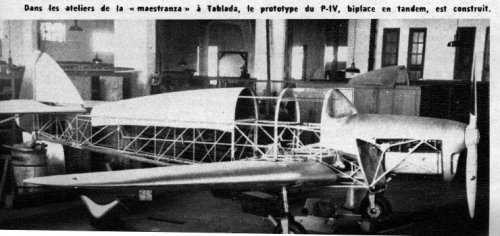 pazo_P-IV_construction_avimag_565_p83s.jpg92.8 KB · Views: 132
pazo_P-IV_construction_avimag_565_p83s.jpg92.8 KB · Views: 132 -
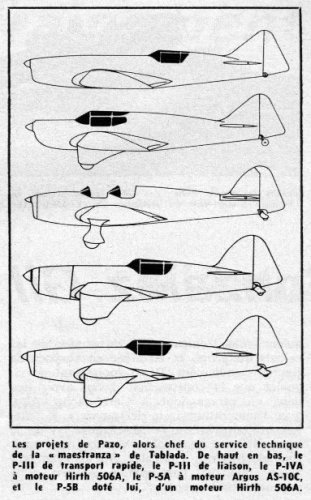 pazo_P-III_P-IVA_P-5A_P-5B_avimag_565_p82s.jpg80.2 KB · Views: 145
pazo_P-III_P-IVA_P-5A_P-5B_avimag_565_p82s.jpg80.2 KB · Views: 145
- Joined
- 6 September 2006
- Messages
- 4,839
- Reaction score
- 9,482
There is a photograph of the GP-2 in this month's Aeroplane Monthly (April 2022 issue).
It is part of a selection of 1930s Spanish Navy aircraft photographs submitted by reader Santiago Ferrer Jover of his grandfather's snapshots from his time in the Aeronautica Naval.
It is part of a selection of 1930s Spanish Navy aircraft photographs submitted by reader Santiago Ferrer Jover of his grandfather's snapshots from his time in the Aeronautica Naval.
Attachments
- Joined
- 25 July 2007
- Messages
- 4,304
- Reaction score
- 4,200
Always the problem is the GP-3 ?.
I came across a random mention of the GP-3 as an unbuilt 'transport' in which Joaquín García-Morato y Castaño had an interest in conversion for record-breaking purposes. That yarn had obviously conflated the 'GP-3' with Pazó's later P-III 'fast transport'.
We have no details on the actual GP-3 design. And we are 'missing' a designation for the monoplane bomber design proposed by CAP to replace the Aviación Militar's Bréguet 19 biplanes. It's a stretch but should we at least be considering the possibility that the GP-3 designation belonged to that unbuilt monoplane bomber design?
do you know that the gil paso planes were made by portuguese ingeneersAlways the problem is the GP-3 ?.
I came across a random mention of the GP-3 as an unbuilt 'transport' in which Joaquín García-Morato y Castaño had an interest in conversion for record-breaking purposes. That yarn had obviously conflated the 'GP-3' with Pazó's later P-III 'fast transport'.
We have no details on the actual GP-3 design. And we are 'missing' a designation for the monoplane bomber design proposed by CAP to replace the Aviación Militar's Bréguet 19 biplanes. It's a stretch but should we at least be considering the possibility that the GP-3 designation belonged to that unbuilt monoplane bomber design?
Similar threads
-
-
-
-
Grushin « Brigadnei », « Stal-MAI » and « EMAI-1 »
- Started by Maveric
- Replies: 5
-

